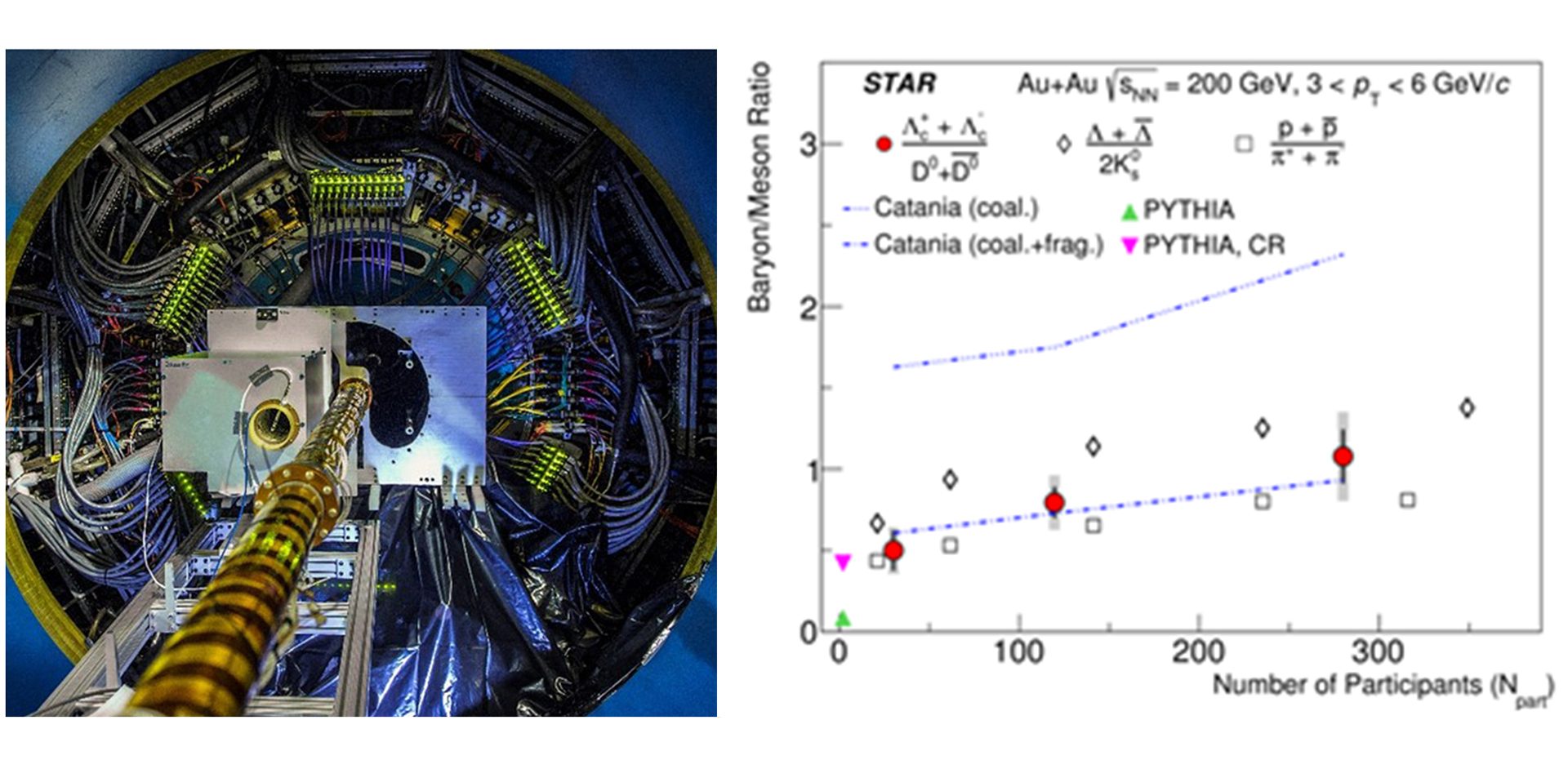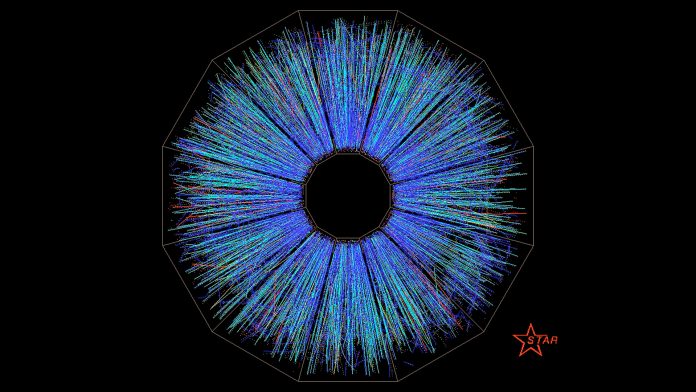Jana Bielčíková, Senior Scientist from NPI CAS and Associated Professor at Czech Technical University in Prague, outlines the role of hard probes for the quark-gluon plasma studies with the STAR experiment at Brookhaven National Laboratory.
Collisions of heavy atomic nuclei at the Relativistic Heavy Ion Collider (RHIC) at Brookhaven National Laboratory (BNL) and the Large Hadron Collider (LHC) at CERN produce tiny droplets of matter called the quark-gluon plasma (QGP). While under normal conditions, the fundamental building blocks of strongly interacting matter – quarks – are tightly bound together by gluons – mediators of the strong nuclear force – in the QGP, quarks and gluons are released and ‘free to move’.
Extreme temperature and densities reached in high-energy nuclear collisions are similar to those of the early Universe just a few microseconds after the Big Bang. When we talk about the building blocks of matter, we usually think of atoms. But atoms consist of a very small nucleus that contains subatomic particles, positively-charged protons and neutrons, their electrically neutral partners. Immediately after the Big Bang, not only atoms but even protons and neutrons were unable to form, as the Universe was too dense and hot. Only a few millionths of a second later, quarks aggregated to form protons and neutrons.
Whilst we cannot recreate in the laboratory the rapid expansion that followed the Big Bang, collisions of atomic nuclei at high energy allow us to learn more about how the Universe developed. In contrast to initial expectations, the QGP behaves almost as a perfect liquid with a very low viscosity and also has other remarkable properties. Being 100,000 times hotter than the core of the Sun, the QGP lives only for a very short time, of the order of 10-22 s. Although the QGP has now been extensively studied for more than two decades at RHIC and over a decade at the LHC, there is still a lot to be learnt to obtain a complete understanding of this unique phase of matter.
To capture elusive characteristics of the QGP, a combination of several probes must be used. Jets and heavy (charm and bottom) quarks, commonly referred to as ‘hard probes’, are considered to be the most ideal ones. As their name suggests, the hard probes originate from rare hard scatterings of quarks and gluons from the colliding nuclei in which a large momentum is transferred. Once created, the hard probes propagate through the QGP and interact with it by losing a part of their energy before flying off to the detectors and transforming to observable particles (‘hadrons’) in a process called hadronization.
The ploughing quarks and gluons thus carry essential information about the entire QGP evolution. The energy loss is, for example, manifested as a suppression (‘quenching’) of hard probes production rate relative to that in collisions of two protons, where a QGP is not expected to be formed. Since the beginning of the RHIC operation in 2000, the STAR experiment has played a key role in the discovery and investigation of jet quenching and heavy quark production, and it continues to pioneer in this area. Below we discuss some recent results into which Czech groups in the STAR experiment contributed.
Jet quenching in the QGP
Jets can be seen in detectors as correlated sprays of particles that form around the original direction of a flying parent quark or gluon. Initially, single particles or correlations of two particles with a large momentum were used as a proxy for jets, as measuring the whole jet in the complex environment of heavy ion collisions is experimentally a challenging task. The reason behind that is a large and fluctuating underlying background of ‘soft’ particles, i.e., particles carrying small momenta and forming the bulk of the QGP matter. This, in combination with small production rates of jets especially at RHIC, required the development of novel analysis approaches. STAR recently reported the first measurement of jet yield suppression in collisions of two gold (Au) ions 1, opening up a new chapter in the study of jet quenching at RHIC.

Fig. 1 shows a STAR event display of a head-on (‘central’) collision with a pair of jets that are back-to-back in azimuth perpendicular to the beam direction, as expected from the hard scattering of incoming quarks or gluons. The right panel of Fig. 1 shows the strong suppression of jets in these collisions, compared to that in glancing (‘peripheral’) collisions, which points to a significant energy loss in the QGP. We note that an absence of suppression would correspond to a value of unity.
The figure also shows a similar measurement by the ALICE experiment at the LHC and for single charged particles at both RHIC and the LHC, which manifest a similar level of suppression. This provides a crucial constraint on theoretical models across collider energies and constitutes a significant step towards meeting the goal of the 2015 US NSAC Long Range Plan to explore the inner workings of the QGP using jet probes. The STAR collaboration is currently working on extending the transverse momentum reach and precision of these measurements using new high statistics data.
How do heavy quarks behave in the QGP?
Precision studies of particles containing heavy quarks in the QGP have become possible mainly in the last decade thanks to advances in the detection of hadrons containing these quarks. Taking advantage of a dedicated Heavy Flavor Tracker (HFT) displayed in Fig. 2, STAR has significantly expanded its capabilities in direct topological reconstruction of heavy flavor mesons and baryons, which decay only several tens of micrometres away from the primary collision vertex. Mesons are particles containing a quark and an antiquark, while baryons contain three quarks.

The HFT has been built as a four-layer high resolution silicon detector utilising its two innermost layers pixel detectors based, for the first time in a collider environment, on the state-of-the-art thin Monolithic Active Pixel Sensors (MAPS) technology with superior track pointing resolution for charged particles over a broad momentum range.2 Besides many interesting measurements performed with the HFT, which include a measurement of charm quark suppression3 and collective flow,4 we highlight here a very challenging and long-awaited measurement of the charm baryon-to-meson ratio that is crucial for understanding how quarks transform in the QGP environment into observable hadrons. An enhancement of the baryon-to-meson ratio in heavy-ion collisions relative to proton collisions has been observed for hadrons containing light (up and down) and strange quarks, respectively, but data for heavy quarks was missing.
Typically, there are two hadronization scenarios considered. Hadronization via coalescence, in which hadrons are formed via recombination of close-by quarks in the QGP that combine their transverse momentum to produce a meson or a baryon with a higher transverse momentum. This scenario favours production of baryons over mesons and can describe well the observed enhancement. Alternatively, a statistical hadronization scheme, which determines hadron yields statistically by their quantum numbers and thermal properties of the system, is used to describe successfully various light and strange hadron abundancies as well. In the right panel of Fig. 2, the baryon-to-meson ratios for light, strange and newly also for heavy quarks are compared 5.
The heavy quark baryon-to-meson ratio, quantified by the Λc/D0 yield ratio, is found to be comparable to the baryon-to-meson ratios for light (p/π) and strange-flavor (Λ/K0S) hadrons. Model calculations that include coalescence hadronization for charm hadron formation can reproduce the STAR data and thus offer significant constraints towards our understanding of hadronization and to the charm quark transport and energy loss in the QGP.
Acknowledgement
The work of the NPI CAS and CTU in Prague groups in the STAR experiment at BNL is supported by the grants LM2018109 and LTT18002 and by European Regional Development Fund-Project ”Center of Advanced Applied Science” No. CZ.02.1.01/0.0/0.0/16-019/0000778 of MEYS, Czech Republic.
References
- STAR Collaboration, Phys Rev. C 102 (2020) 5, 054913
- G. Contin et al., Nucl. Instrum. Meth. A907 (2018), 60
- STAR Collaboration, Phys. Rev. C 99, (2019) 034908
- STAR Collaboration, Phys. Rev. Lett. 118 (2017) 212301
- STAR Collaboration, Phys. Rev. Lett. 124 (2020) 17, 172301








